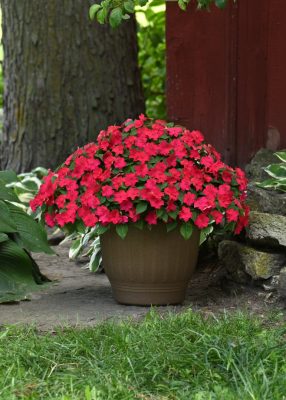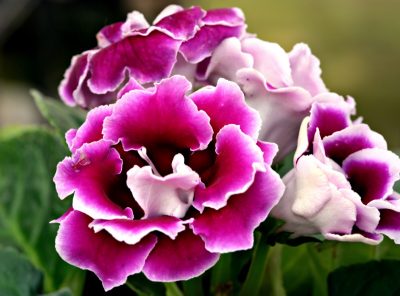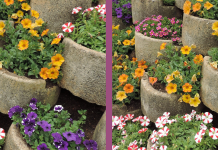Be blown away by luxurious velvety flowers, popping lipstick shade petals and light perfume-scented bright edible flowers.

We’re planting… Impatiens Beacon ‘Lipstick’ which is a new colour in the highly disease resistant Beacon range of bedding impatiens. It is a vivid vermillion, just what we need to usher in spring. The Beacon Impatiens is a fast-filling bedding impatiens for light shade or semi-shade. It flowers non-stop from spring through to autumn and nothing else quite matches it for colour and impact in the garden, as a border or massed. Plant in fertile soil, spaced 15 to 20cm apart and feed with a liquid fertiliser after planting and once a month thereafter for good flowers. Impatiens like consistently moist but not soggy soil. The more sunshine the plants get, the more water they need, with less in shadier areas. Details: ballstraathof.co.za
 There’s something luxurious, and very touchable about the velvety flowers and leaves of Gloxinia. Despite its exotic looks, Gloxinia is an easy to grow houseplant that likes a warm, bright position and only lightly moist soil. Like indoor violets, Gloxinia don’t like wet leaves. An easy way to water them and keep the leaves dry is to put the pot in a bowl with shallow water. Allow to plant to soak up the water for about 15 minutes, then take it out and allow the pot to drain. Feed once a month with a liquid fertiliser diluted at half-strength. Details: lvgplant.co.za
There’s something luxurious, and very touchable about the velvety flowers and leaves of Gloxinia. Despite its exotic looks, Gloxinia is an easy to grow houseplant that likes a warm, bright position and only lightly moist soil. Like indoor violets, Gloxinia don’t like wet leaves. An easy way to water them and keep the leaves dry is to put the pot in a bowl with shallow water. Allow to plant to soak up the water for about 15 minutes, then take it out and allow the pot to drain. Feed once a month with a liquid fertiliser diluted at half-strength. Details: lvgplant.co.za
 Herb of the month
Herb of the month
Evening Primrose (Oenethera Biennis) is more than just a beautiful garden herb that opens its flowers as evening approaches, spilling out its light perfume.
The bright yellow flowers play a very important role in attracting beneficial insects that prey on pests and are a magnet for pollinating bees and butterflies.
Every part of this plant can be used. The leaves can be cooked and eaten as greens. The flowers are sweet and can be used in salads or as a pretty garnish. Roast the ripe seeds in an oven and use on bread or sprinkle over salads. As with all edible flowers, use sparingly until you know how they affect you, especially if you have plant allergies. Evening primroses grow best in full sun but will tolerate partial shade. Sow between spring and autumn. They can grow in poor soil as long as it drains well. The flower spikes/inflorescences are produced in the second year and reach up to 1m so it’s a good idea to position them towards the middle or back of a bed. Plants will survive long periods of drought but will grow and flower better with regular watering. Although they die down in winter, cutting down the plant to the ground will stimulate new growth in spring. Details: kirchhoffs.co.za
Garden tasks for August
- August is a windy month. Check the ties of standard roses and all other standard plants that are supported by stakes and stake newly planted trees.
- Prepare the soil for spring planting by digging in compost and other organic material. • Start sowing spring vegetables in seed trays and keep them in a warm, sheltered corner. • Increase watering to once a week for most plants and fertilise all plants. • Give the lawn its spring treatment. Rake out all the dead grass and then cut the lawn with the lawnmower on its lowest setting. Compacted ground can be spiked with a garden fork or a hollow tine fork. Apply lawn fertiliser and water in well. • If the lawn has hollows, is uneven or there are dead patches, level it with lawn dressing. Fertilise and water well. • Do some garden maintenance – remove leaves from gutters and fix any broken ones, clean the garden furniture and treat any wooden garden furniture.






